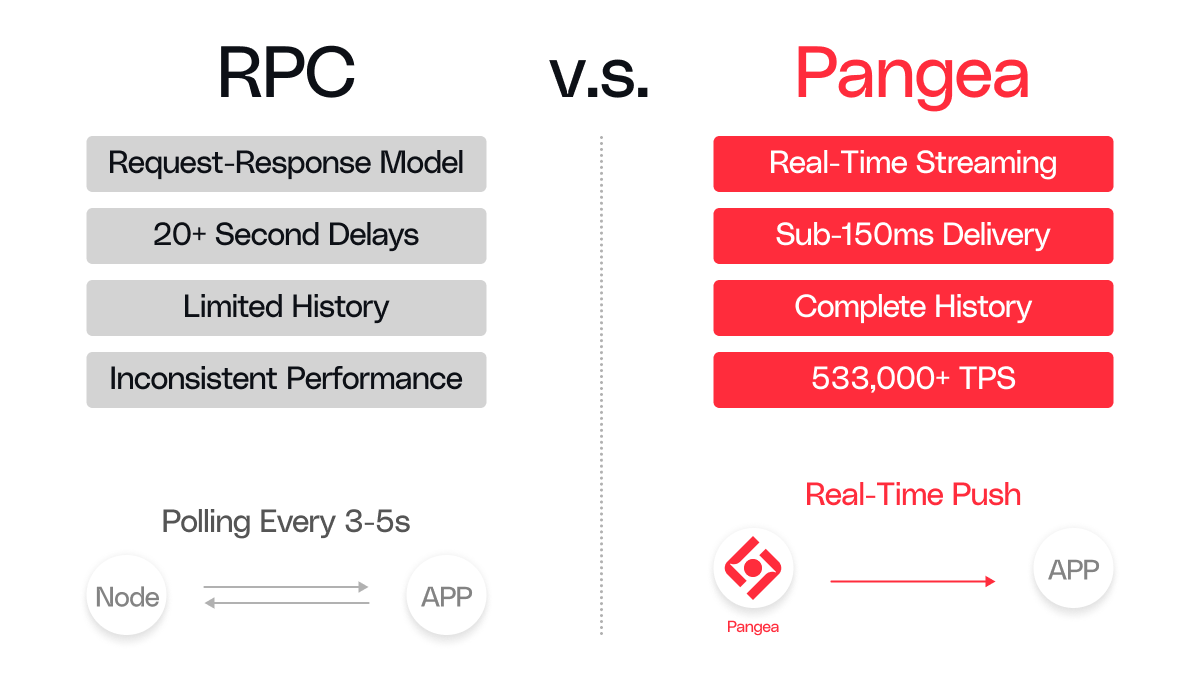RPC vs Pangea

The excitement of speed is like a drug; one can never get enough of it.
- Enzo Ferrari
As blockchain ecosystems compete for developer attention and user adoption, the infrastructure decisions made by chain ecosystems become critical strategic choices. The quality of developer tooling directly impacts which protocols choose to build on your chain, and ultimately, whether end users embrace these applications. In today's competitive landscape, user experience is the kingmaker and as we've demonstrated with partners like Movement Labs, only the Pangea method of streaming infrastructure can deliver the sub-second responsiveness that todays use cases demand.
The RPC Challenge
Traditional RPC endpoints present several critical limitations for modern protocols:
- High Latency: long delays that are unacceptable in today's user experience standards
- Inconsistent Performance: degraded services during high network activity right when reliability matters most
- Limited Historical Data: restricted access to chain history constrains application functionality
- Resource Intensive: requires excessive polling and redundant node setups to maintain competitive performance
Using RPC to quote for a swap can take around 15 seconds. Most Uniswap style dApps continuously poll for updates.
Example RPC death calls kills UX for a popular DEX on Base
Now we have faster blockchains the problem gets worse
Modern faster blockchains achieve their speed by exposing multiphase consensus mechanisms as a feature rather than hiding them internally. Now, traditional consensus mechanisms are split into 4 stages:
- proposal,
- validation,
- pre-commitment, and
- final commitment.
By surfacing the pre-commitment phase to applications through preconfirmations, these blockchains allow developers to build user experiences that respond to transactions following initial validator quorum but before they achieve finality.

Fast blockchains have solved a core challenge providing faster transaction feedback while maintaining blockchain security guarantees. Several chains have achieved sub-second blocktimes and transaction streams with a multiphased approach. Implementations from Solana, Monad, SUI, Base and MegaETH vary, but they now pose a challenge for how developers build their applications.
By implementing multiphase consensus mechanisms, blockchain networks have created competing protocol interfaces:
- MegaETH splits its API between a new "Real-time API" for preconfirmations and the traditional Ethereum RPC.
- Base Flashblocks delivers preconfirmation data through WebSocket streams featuring initial block data followed by "diff updates".
This bifurcated approach forces developers to integrate with multiple APIs simultaneously, increasing development complexity and creating inconsistent user experiences across applications on an already broken RPC interface.
How can we keep up with the pace of faster blockchains and allow our developers to build great user experiences?
Pangea
Pangea accelerates blockchain data infrastructure through direct chain integration. We capture previously hard to get data points and stream them through our purpose-built real-time database. Our indexing language decodes, joins, and aggregates raw blockchain data in milliseconds, delivering useable information to end users instantly, unleashing the true speed of modern blockchains.

Real-Time Streaming Architecture
Rather than relying on request-response patterns, Pangea pushes data directly to applications in real-time. This streaming model eliminates polling overhead and delivers data "in the blink of an eye", under 150ms, the threshold where human perception notices delay.
Complete Historical Access
Applications need more than just current state. Pangea provides immediate access to full historical data, enabling richer user experiences and more sophisticated protocols.
Performance That Scales
With the capability to index chains at speeds exceeding 533,000 TPS, Pangea's infrastructure scales with blockchain performance rather than becoming a bottleneck.
Real-World Impact
Our recent work with Movement Labs protocols demonstrated this stark contrast. After initially struggling with standard RPC implementations, teams that switched to Pangea experienced:
- Load times reduced to sub-second
- Consistent performance during network congestion
- Ability to implement features previously considered impractical due to RPC constraints
- Big reduction in infrastructure cost and maintenance
Beyond Infrastructure Replacement
What makes the Pangea method truly transformative is that we don't just provide better infrastructure, we help protocols rethink their data architecture. In many cases, we've worked directly with teams to rewrite portions of their applications to fully leverage Pangea's capabilities.
The results speak for themselves, protocols that initially came to us in crisis are now delivering user experiences that rival Web2 applications in terms of responsiveness and reliability.
As chains accelerate and increase complexity, traditional RPC patterns create a widening infrastructure gap. Pangea is not a better mouse trap - it's an evolutionary leap forward establishing its own category by redefining how users experience crypto. To date, Pangea offers the only viable solution for protocols with high performance use cases.


